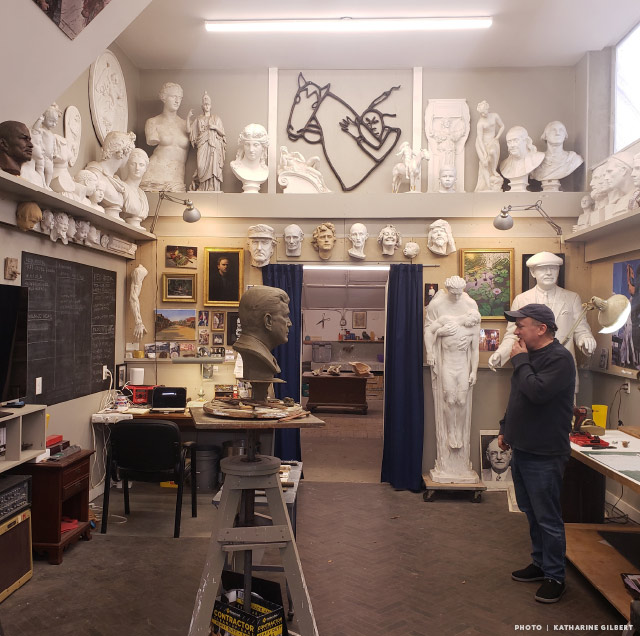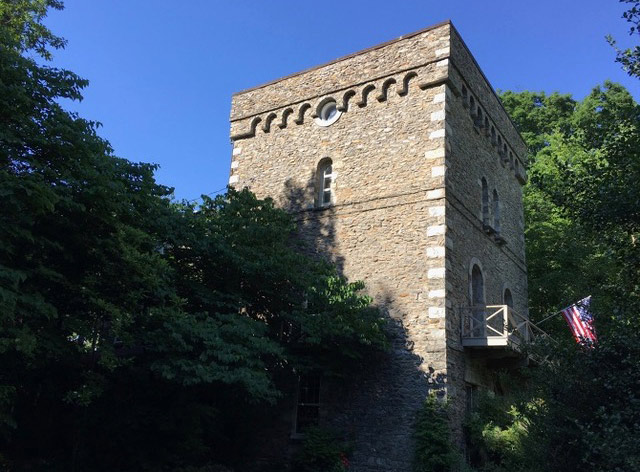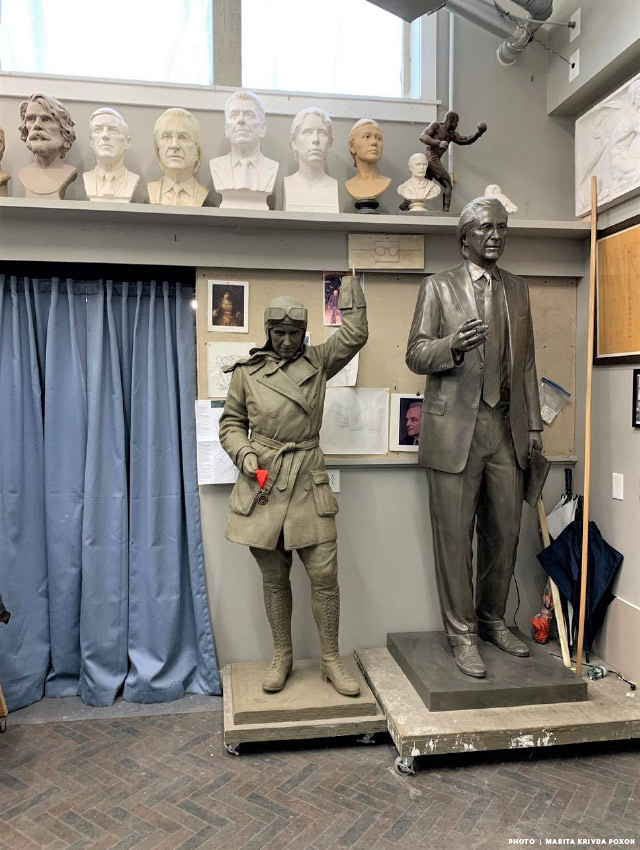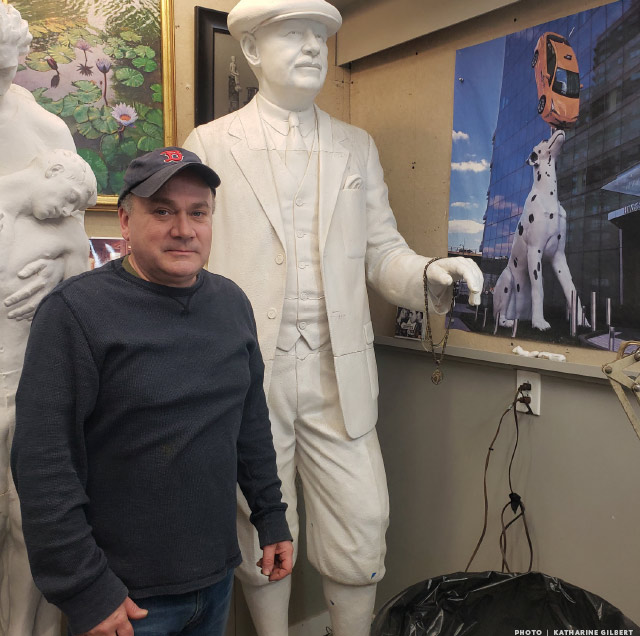Caption Above: Finishing a sculpture of a friend’s father.
By Marita Krivda Poxon
Not many people live in a castle, but the renowned Philadelphia born sculptor, Chris Collins, does and what a castle it is. Called Edgehill Castle and named after nearby Edge Hill Road, it was the site of a Revolutionary War battle.

The famous 19th century American artist Russell Smith built Edgehill in 1854 as his home and studio. It resembles Rosslyn, a medieval castle in Scotland. Russell Smith’s father was born in Rosslyn Castle and his ancestors took care of the castle.
Collins made Edgehill his home and studio since 2000, when he came to help his mother, Sandra Collins, take care of his father John F. Collins who suffered from Parkinson’s. John F. Collins was a distinguished landscape architect and chairman of Landscape Architecture at Temple University.
His parents purchased Edgehill in 1998 for its nearly four acres of great black soil. The site has been used ever since for Collins Nursery, which is a family business that has sold container grown native plants for 25 years. Also, Chris’s father needed proximity to Philadelphia where his landscape firm, Delta Group, was located.
When Chris and his wife Anchalle moved into Edgehill, they never looked back. Chris converted an old barn into a spacious studio for mold making, casting and sculpting his large figures. Additionally, within the castle itself, Chris continues Russell Smith’s legacy by using the original light filled second floor studio as his own second studio for detailed drawing, computer imaging and refining sculptural pieces.

Born in 1966, Chris grew up on Gowen Avenue, Mt. Airy, in a large Irish American family nearby his life-long friend Neil Duffin, Jane Duffin’s nephew. Along with his three siblings, he attended Holy Cross Parochial School where he was a lackluster student at best. Later he enrolled in LaSalle College High School. What did inspire him, as well as his older brother John R. Collins, was learning to draw under his father’s sharp eye and encouraging tutelage.
In 1979, his father designed Chestnut Park (later called John F. Collins Park) located at 17th and Chestnut Streets in Center City. Chris sculpted a wolf’s head which was cast in bronze and placed on the fountain. At eleven years old, it was his first work of public art.
Chris also derived his artistic ability from his father’s mother, Florence Manning Collins, who taught art in Conshohocken and encouraged his growth.
Chris enrolled in the School of Visual Arts in New York City in 1984, where he majored in Illustration and graduated with a BFA in 1988.

After New York City, he headed up to Boston where he worked for 10 years, initially a sculpture apprentice and mold maker. He was fortunate to study under two classically trained sculptors: Walker Hancock and Moisey Altshuler. For five years he worked with them at Skylight Studios in Woburn, Massachusetts. There he learned how to design and create figurative sculpture, how to make molds and models to replicate historically important sculptures and how to restore museum pieces.
While working in Woburn, he lived above the Caproni Gallery where he befriended master craftsman, Lino Guist, who helped him hone his museum reproductions, mold making, casting and patina skills. In 1995 his expert training allowed him to open his own business, Collins Studio.
In 2000 when Chris’s father became very sick with his advanced Parkinson’s disease, he moved back to Philadelphia. He moved into Edgehill Castle —his new home and studio.

Chris began working on many publicly and privately funded art projects. One of his famous public projects was with his architect brother John. It is located in Montana and is called the Little Bighorn Battlefield National Memorial “Spirit Warriors,” commissioned by the National Park Service.
A privately funded sculpture done for the Union League Golf Club at Torresdale, is a seven-foot-tall bronze statue of the famous golf course architect, Donald Ross.
In 2017, he created a 10-foot-high Carrara marble sculpture of the trial lawyer, Tom Kline, for Drexel University. Drexel named their new law school, the Thomas Kline School of Law, to thank him for a 50 million dollar gift. For this sculpture, Chris traveled to Pietrasanta, Italy to learn to carve in marble to complete the statue. Chris is very proud that his Tom Kline sculpture is the first Philadelphia public sculpture done in marble in nearly 100 years.
As an illustration major and a private student for four years of master realist painter Thomas Ouellette, Chris also has considerable skills as a portrait painter. He has done portrait paintings for Drexel University, Philadelphia College of Osteopathic Medicine, Episcopal Academy and many others.
Born into a large Irish-American family, Chris freely admits that his father, John F. Collins, was prouder of his Irish heritage than he has been. His grandfather, William Collins, was even prouder than his son.

Chris gives credit to his Collins descendants, the extended network of his Irish-American cousins for how beautiful Edgehill Castle looks today. They really helped him afford the renovations of the castle; the restoration of the old barn into his studio; the building of patios, walkways and walls and the myriad other tasks that helped to transform the castle along with its heavily wooded grounds, into the showplace it now is.
Chris praises them:
“The only reason I could handle getting this property in shape is that I have around 25 cousins. They are all Irish and can do most anything. I have one cousin who is a contractor with heavy equipment who installed sewers and water lines; three cousins who are carpenters; I myself did all the stone walls, patios, cobble stone walks; my father did all the landscape design. This work saved Edgehill Castle. Anyone else who bought it would have had to spend way too much money. Just the castle walls are almost three-feet thick. We totally restored it taking us 15 years, spending a tenth of what anyone else would have spent.”
Like Chris Collins’s magnificent sculptures, Edgehill Castle has become a national treasure brought back to life again as a sanctuary for the creation of art which will endure as has the art work of Edgehill’s builder, the artist Russell Smith.


Thanks for a wonderful description of this artist and the castle which was heretofore unknown to me . Chris is living his dream and that’s a powerful message for everyone. However, the help from close knit caring loved ones and all those talented cousins further illustrates the beauty of family!